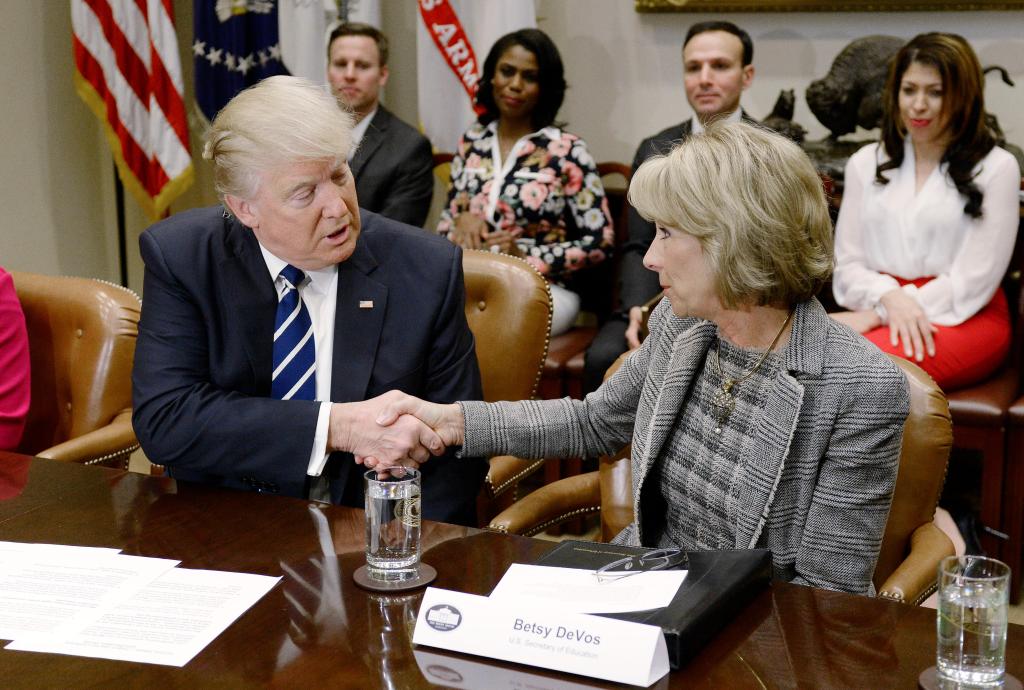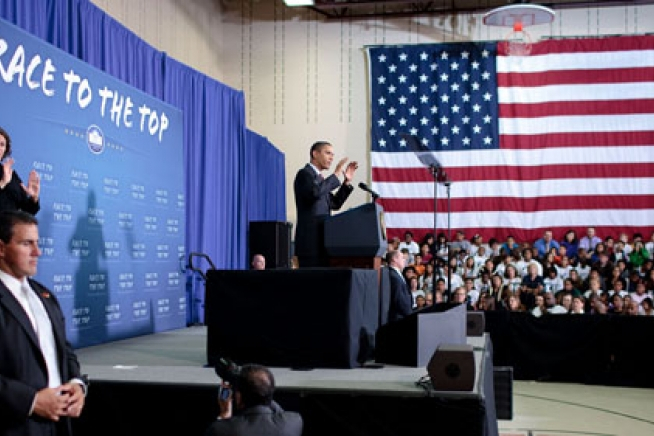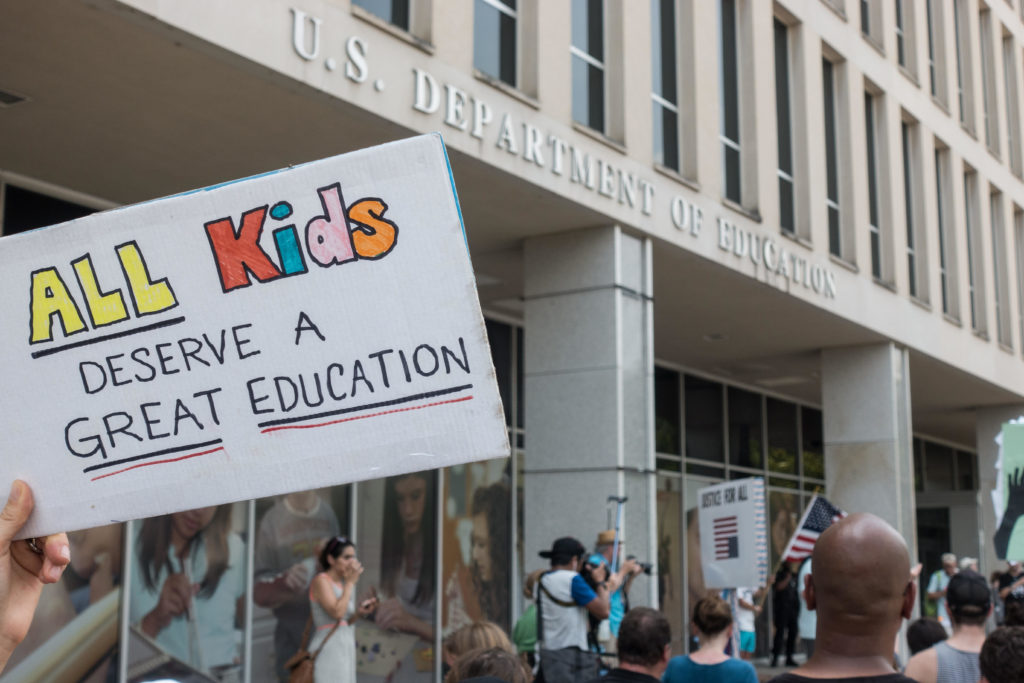From the Race to the Top to the Plunge to the Bottom
The Pandemic and Federal Education Policy
Illustrator: Nate Kitch

Horror movie sequels are notoriously bad. This one may be the worst.
In 2009, federal intervention during the last financial crisis gave rise to the Obama administration’s signature education initiative: the Race to the Top (RTTT). Created with $4.3 billion from the American Recovery and Reinvestment Act, RTTT weaponized its forerunner, the No Child Left Behind Act, and led to new levels of assault on unions, the teaching profession, and public schools, and to a decade of damaging privatization. Its two primary weapons of mass destruction were tests and charters.
It took years of resistance, pushback, and policy failures to turn the tide. NCLB and RTTT were ultimately unsustainable and failed to deliver on their promises. As the 2018 Red for Ed teacher strike wave and the early stages of the 2020 presidential campaign showed, resistance and activism helped shift the focus of national education politics from charters and tests to school funding and teacher salaries. Mobilized, militant teachers became the voices of communities digging out from decades of austerity, and support for public education was again on the rise.
But now the Trump pandemic, and the lethal fiasco of the response by U.S. economic and political institutions, has remade the education landscape again. We are back in shock doctrine, disaster capitalism territory and public schools are again in the crosshairs. Teachers are quarantined at home behind computer screens instead of mobilizing in the streets, and school communities are scattered, atomized, and struggling with uncertainty.
The Implications for Federal Education Policy
The emergency CARES Act, passed without a single dissenting vote and signed in March, was the first of several massive pieces of federal legislation rushed through Congress in response to the pandemic. While the CARES Act didn’t include the same kind of signature federal initiative that RTTT represented for Obama and his secretary of education, Arne Duncan, it did give Duncan’s successor, the wildly unpopular, right-wing billionaire Betsy DeVos, extraordinary powers in a host of important policy areas.
There will be additional federal action affecting schools in the months ahead, including attempts to address the financial tsunami that is already engulfing school budgets. But even a cursory comparison between the federal response in 2009 and the initial response to the current crisis provides some clues about the extended emergency ahead for public education.
The CARES Act included $13.5 billion for K–12 schools, $14 billion for higher education, and another $3 billion that governors can split between the two as part of $31 billion in “stabilization aid” for state budgets. But while the total $2.2 trillion legislative package was several times larger than the $800 billion American Recovery and Reinvestment Act of 2009, the initial amounts provided for education in the CARES Act were much smaller.
The Recovery Act sent $54 billion in education aid to states primarily for K–12 programs and the implementation of RTTT. Moreover, as noted by Education Week, the “2009 stimulus didn’t just shore up education budgets; its unprecedented windfall of education aid also helped the Obama administration put financial muscle behind its priorities. Those priorities focused on areas like standards and accountability.” To promote those policies, the funds came with prescriptive regulations about their use, including provisions that drove an expansion of charters, standardized testing, and test-based teacher evaluation. States and school districts desperate for federal dollars had to commit to this agenda to receive RTTT’s “competitive grants.”
“The CARES Act doesn’t take the same approach,” Education Week’s analysis concluded. “It’s hard to see discrete elements of a Trump education policy agenda driving current coronavirus aid — although U.S. Secretary of Education Betsy DeVos indicated last week she wants to change that.”
The CARES Act gives DeVos multiple tools to do so. It gives the secretary of education authority to waive many requirements outlined in the Every Student Succeeds Act (ESSA), the omnibus federal education legislation that replaced NCLB. The first — and undoubtedly most popular — use of this authority came when all 50 states sought and received in a matter of weeks a waiver to suspend federally required annual standardized testing for the current school year. The educational irrelevance of these tests and their existence as an obstacle to serving the real needs of students was one of the first lessons of the pandemic.
DeVos Given Tools of Destruction
But DeVos’ new authority has much more sinister potential. The CARES Act gives her the power to waive Title I funding regulations, which govern the largest federal education program supporting children from low-income families. It also allows her to suspend Title II rules defining professional development and Title IV requirements to “provide students with a well-rounded education” including the arts, mental health services, and training on trauma-informed practices — all crucially important in the current crisis. The CARES Act specifically allows schools to shift money from these areas to purchase “digital devices.” By early April, 28 states had received waivers to reallocate ESSA spending.
In the guidelines for distributing the first pot of CARES funding, the $3 billion Governor’s Emergency Education Relief Fund, DeVos blocked any use of funds to support DACA recipients or international students. She also said any monies awarded to teacher unions to provide services defined in the CARES Act would be “inconsistent with statutory requirements,” although last year she authorized church and religious groups to receive federal funds to provide similar services.

DeVos has a long and notorious record of using agency guidance and regulatory action to undermine equity. One of her first acts after being confirmed as secretary was to support the repeal of protections for transgender students, including their right to choose restrooms. She was sued for rolling back protections against predatory lenders at for-profit colleges and threatened with jail by a federal judge for “intentionally flouting” a court order to stop collection proceedings for such loans. DeVos rescinded sexual assault guidance issued under Title IX, a move the National Women’s Law Center said would have a “devastating” impact, and in May released new guidance that weakened protections for victims of sexual harassment and assault. She proposed allowing schools to use federal “student enrichment funds” to purchase guns and used a school safety commission formed in the wake of the Parkland school shootings to recommend repeal of regulations on school discipline practices that were rooted in civil rights concerns. Similarly, DeVos tried to rescind Obama-era rules that required districts to track racial disparities in special education classification rates, an effort a federal judge blocked as “arbitrary and capricious.” In April, DeVos relaxed oversight and accreditation rules for higher education online programs at a time when the pandemic was massively expanding the scale of such programs.
Beyond putting her very rich thumb on the wrong side of the scales of justice, DeVos is now in position to be a key gatekeeper for a new and crushing era of austerity for school budgets.
Beyond putting her very rich thumb on the wrong side of the scales of justice, DeVos is now in position to be a key gatekeeper for a new and crushing era of austerity for school budgets. To access the CARES Act’s stabilization funds, states must nominally commit to maintaining recent levels of education funding for fiscal years 2021 and 2022. But DeVos can waive that requirement and no doubt will. Already, she has issued guidelines for distributing CARES Act funds that drive more dollars to private schools and wealthier students by circumventing requirements to allocate the funds according to more progressive Title I formulas.
Because of DeVos’ long record of regulatory sabotage, Sen. Patty Murray (D-WA) successfully pressed for CARES Act language that would prevent her from implementing waivers from the Individuals with Disabilities Education Act (IDEA) without specific congressional approval. But IDEA itself still gives DeVos the authority in “exceptional or uncontrollable circumstances,” like a pandemic, to waive the requirement that states maintain current levels of special education funding in order to access IDEA funds.
Typically, federal law requires states receiving dedicated allocations of federal education aid to use it to “supplement” rather than “supplant” their education budgets. But historically, administrations — Democrat and Republican — have done little to enforce that rule. Duncan used the 2009 crisis to declare austerity “the new normal,” ushering in an era of state and local cuts that cost more than 300,000 school employees their jobs and took school budgets more than a decade to even partially recover from.
After a Decade of Pain for Schools, More Cuts
One reason schools had such a hard time recovering from the 2009 crisis was because of the way “relief efforts” were structured at both the federal and state level — policy failures that seem likely to be repeated in the current crisis. Because the supplement-not-supplant rules were not enforced, the Obama administration’s two-year program of education stabilization grants was used to plug budget holes without requiring reform of inequitable and inadequate state funding systems. When the federal subsidies ended, state school aid “fell off a cliff.” And because many states adopted austerity policies that starved state treasuries of needed revenues and imposed caps on local sources of revenue like property taxes, the budget holes deepened. By 2017, combined state and local education spending remained below pre-recession levels in 22 states and the District of Columbia.

Even as the economy recovered in the years after 2009, the vise of austerity continued to squeeze schools. A recent report from the Shanker Institute documented a 25-year decline in the percentage of personal income that went to state and local taxes. What school finance experts call “effort” — the share of state economies devoted to supporting K–12 education — decreased sharply through 2012 and hasn’t recovered. “This was not an accident or random confluence of events,” the Shanker Institute report noted. “It was — and still is — due in no small part to policymakers’ refusal to raise sufficient revenue to fund public services, including education.”
Expanded federal aid could be used as a lever to increase the “effort” and fairness of state school funding systems. But federal and state policy decisions have instead steadily eroded the funding mechanisms that support public education and left it increasingly vulnerable to repeated crises, with disproportionate impact on high-poverty districts most dependent on state and federal aid.
The scale of coming cuts is likely to be much worse than the last meltdown even as the current crisis imposes larger challenges on public schools.
The scale of coming cuts is likely to be much worse than the last meltdown even as the current crisis imposes larger challenges on public schools. As bad as the Obama/Duncan era was for public education, the current administration is even more hostile, much more corrupt, and more committed to an all-sided privatization agenda. Attempts to save public education now compete with efforts to preserve the most elemental features of U.S. democracy like the post office and credible elections. Sustaining public education will be just part of the struggle to save the “common good” from predatory, shock doctrine policies.
Before the ink was dry on the CARES Act, a coalition of public education advocacy groups, including the two national teacher unions, sought a $200 billion package of support for education budgets with 90 percent directed to local school districts. The request, which dwarfed the $13.5 billion for K–12 education included in the CARES Act, went nowhere. Several additional rounds of federal bailouts for corporations and businesses totaling about $3 trillion contained minimal support for state and local governments, and those relatively small sums came with rules that limited their use to fill budget gaps or offset the massive decline in revenues caused by economic collapse and quarantine.
In contrast, the CARES Act included a $500 billion fund under the control of Treasury Secretary Steven Mnuchin to be doled out to large corporations with virtually no oversight or even public identification of the recipients. The Federal Reserve is providing hundreds of billions of dollars to oil, gas, and other corporations without requiring maintenance of payrolls, caps on dividends, or any limits on executive compensation.
More than 80 percent of the tax breaks in the CARES Act went to 43,000 individuals who earn more than $1 million. A single change in something called the “pass-through” rules for calculating business tax liabilities “will cost taxpayers about $90 billion in 2020 alone” according to the Washington Post. That’s more than four times what states spend annually on public worker pensions.
In the first months of the pandemic, as more than 30 million people filed for unemployment and the toll of largely preventable deaths crossed 100,000, U.S. billionaires like Amazon’s Jeff Bezos and Zoom’s Eric Yuan grew hundreds of billions of dollars richer and the stock market had its best month in more than 30 years.
This looting of the public treasury and the serial federal bailouts for corporations and banks are familiar signs of shock doctrine politics that seize on crises to impose authoritarian “emergency” measures that undermine democracy and redistribute wealth and power upward. They also deepen long-standing racial and class inequalities built into the foundations of U.S. society.
Pandemic Politics and the Common Good
The next stage of pandemic politics will include a struggle over the scope and dimensions of additional federal aid for states and cities — and potentially, schools. With millions of public workers facing imminent layoffs and a pivotal national election on the horizon, another large relief package seems inevitable. Equally inevitable will be efforts to shape the legislation to promote competing political agendas and, especially, to facilitate or oppose privatization and austerity.
The stakes for schools are monumental. According to one Education Week analysis, “America’s public schools will need $70 billion for three consecutive years in the next round of federal stimulus spending to avoid painful cuts such as teacher layoffs.” Estimates from the Economic Policy Institute and the Center on Budget and Policy Priorities forecast that state and local governments will need $500 billion in federal funds over the next one to two years to maintain basic services.
Republican efforts to delay or limit the next round of federal response began immediately after the bank and corporate bailouts were signed. They include attempts to narrow the size and scope of future bills and efforts to advance right-wing policy initiatives that drive education funds to charters and voucher-like schemes.
DeVos has been similarly active looking for new paths to privatization.
Some examples of what this looks like surfaced early on in posturing by Senate Majority Leader Mitch McConnell. David Dayen wrote in the American Prospect that “First, McConnell floated that cities and states should go bankrupt instead of receiving financial aid to prevent a depression. That was a thinly veiled attempt to bust public employee pensions. Then, he said that any future bill must include a broad liability shield for reopened businesses, protecting them from lawsuits over COVID-19 infections. This is just a pure set of talking points from the Chamber of Commerce and the National Association of Manufacturers, whose members don’t want to invest in keeping workers and customers safe and who would rather get Congress to bail them out from that investment.”
DeVos has been similarly active looking for new paths to privatization. On April 27 she announced plans to use $180 million in CARES Act funds to provide voucher-like “microgrants” directly to students or families to “help students continue to learn” while schools are closed. The grants would allow parents to buy online educational services, computer devices, or pay tuition fees at virtual schools. “I’ve always believed education funding should be tied to students, not systems, and that necessity has never been more evident,” she said.
The right-wing Heritage Foundation saw an even larger opportunity to remake state funding systems. Its National Coronavirus Recovery Commission declared, “The spending flexibility offered through the CARES Act is an example of systemic change that could help schools now and in the future. . . . States should immediately restructure per-pupil K–12 education funding to provide education savings accounts (ESAs) to families, enabling them to access their child’s share of state per-pupil funding to pay for online courses, online tutors, curriculum, and textbooks so that their children can continue learning.”

DeVos has already proposed “Education Freedom Scholarships” that would give federal tax credits to those who donate to school scholarship programs for private school tuition. She also announced $65 million in new grants to fund the creation or expansion of more than 100 charter schools across the country. Education reporter Jeff Bryant noted that the two largest grants went to charter chains with histories of malfeasance — the IDEA chain in Houston, which budgeted $2 million for a luxury private jet until media exposure upended the plans, and Mater Academy in Florida, which has been the subject of investigation for questionable real estate deals.
These efforts to promote privatization will dovetail with systematic attempts to reimpose austerity on teachers and school budgets. In an Education Week interview with conservative education pundit Rick Hess, Marguerite Roza, a former senior advisor to the Gates Foundation on school finance, echoed Arne Duncan’s “new normal” of a decade ago: “This new reality is the equivalent of a U-turn from only a few months ago, when teachers were winning raises and governors were making commitments to new education programs like pre-K, mental health supports, computer science, and so on. Some states will start by eliminating those newer initiatives, delaying promised pay raises, and more. Where states have holes in their pension funds (and most do), the declines in the stock market will exacerbate those.” Roza suggested districts should consider hiring freezes, canceling “across-the-board” raises, and four-day weeks.
The budget butchery is well underway. In New York, the first state to adopt a budget in the wake of the CARES Act, Gov. Andrew Cuomo demanded authority to cut state school aid “on a rolling basis.” A report from the Education Law Center showed how Cuomo’s “‘pandemic adjustment’ is actually a ‘pandemic cut’ in New York State school aid, backfilled with the federal CARES Act emergency relief funds.”
“The pandemic adjustment replicates the strategy used by states to cut K–12 education funding during the 2008 Great Recession.”
– Report from the Education Law Center
“These cuts most impact students in New York City and other high-poverty districts,” the report read. “The pandemic adjustment replicates the strategy used by states to cut K–12 education funding during the 2008 Great Recession.”
At the same time, Cuomo named billionaire Bill Gates to lead efforts to “reimagine education” in New York. The governor’s “advisory group” did not include any K–12 students, teachers, principals, or parents from New York City, the nation’s largest school district.
Public school advocates will need to push Congress hard to fight for policies that promote equity over austerity, that ensure public funds go to public schools and public purposes, and that strengthen rather than weaken federal commitments to educational equity. Key elements should include:
- Multiyear federal funding with strong requirements that states maintain recent levels of school spending and improve the fairness of their funding systems.
- Distribution of federal aid according to progressive formulas that send more funds to higher-poverty districts and schools.
- Massive new federal investment in the educational facilities and public health resources needed to reopen schools in the midst of a pandemic.
- Insistence on using public funds only for public schools.
Education advocates will also need to form coalitions with advocates in other areas, like health care, housing, climate justice, and immigrant rights to build both short- and long-term movements to change federal budget priorities.
A Turning Point or a U-Turn?
Ten years ago, the Race to the Top was the culmination of decades of bipartisan education reform politics that moved federal education policy in the wrong direction: away from its historic role as a promoter of access and equity through support for things like school integration, extra funding for high-poverty schools, and services for students with special needs, to a much less equitable set of mandates around standards and testing, promoting charters, and undermining unions that reinforced racial disparity and promoted privatization.
The early rounds of federal response to the latest crisis have continued servicing private corporate interests while weakening the public sector at the very time that broad, popular support for expanding its reach is increasing. We also see daily evidence of how unending corruption, the lack of effective political opposition at the national level, and the acute absence of democracy are also part of the afflictions ravaging the country.
It’s relevant to remember that the spiraling pandemic that forced the federal government to move, in a matter of weeks, from entrenched bipartisan gridlock to unprecedented fiscal and budgetary expansion overlapped crucially consequential political developments on the national stage. For months, progressive forces had captured the initiative in the 2020 Democratic primaries and, for a moment in mid-February, democratic socialist Bernie Sanders seemed on the verge of consolidating a commanding lead for the Democratic nomination. Then, in the space of three weeks, just as the scope of the pandemic was becoming apparent, centrist political forces moved to block Sanders’ ascent and install Joe Biden as the presumptive Democratic nominee, soon winning even Sanders’ endorsement.
These developments had a direct impact on the federal pandemic response. While Biden, a deeply flawed candidate with a long list of liabilities, virtually disappeared, the Democratic leadership in Congress played an ineffective, defensive, and timid role in the first wave of federal response. Republicans seized the initiative and unapologetically promoted the interests of the 1 percent over those of the overwhelming majority of the population.
Instead of building on the progressive momentum evident in the primary campaign — and on years of hard-won grassroots organizing and progressive advocacy that had finally begun to break the bipartisan consensus around austerity politics — the Democrats yielded the legislative initiative to McConnell and the media stage to Trump’s absurd daily “briefings.”
Instead of centering proposals guaranteeing health care for all; declaring moratoriums on debt, rent, evictions, and foreclosures; saving the Post Office; expanding universal mail-in voting; boosting direct income subsidies to working families; and expanding aid to state and local governments — including schools — the Democratic leadership negotiated almost exclusively on Republican terms about the size of the small and large business bailouts. Instead of using their leverage to rein in and expose predatory corporate behavior, they accepted pitifully weak “oversight” that was dismissed by Trump out of hand. The performance was an echo of the Democratic Party leadership’s narrow and ineffective impeachment debacle.
After squandering much of the party’s leverage and ratifying Republican priorities in the early weeks of the crisis, House Speaker Nancy Pelosi finally released the “Heroes Act” in mid-May. The $3 trillion legislation contained some items Democrats should have been fighting for from the start (massive aid for states, cities, and schools), left out key essential measures (guaranteed income supports and health care for all), and included some abominations (bailouts for lobbyists, mortgage companies, and health insurers). The bill, which narrowly passed in the House despite objections from the party’s most progressive members, was immediately seen as a negotiating tool with Republicans whose opening bid for the next relief package was nothing for working families and liability protections for employers and businesses.
The dismal performance of the Democratic Party leadership has not been just a misstep. It was also a reflection of the defeat of progressive forces in the primary and an ominous sign of low expectations for the Biden campaign. Rebounding from that defeat and recapturing the initiative that social movements had been building throughout the primaries will be keys to mobilizing a majority coalition of those desperate to defeat Trump and the Republicans in November. It will also be key to any chances of developing a vision and a program that can preserve and improve public education in the wake of another deadly round of disaster capitalism.
The outcome will have generational consequences. In April, two high school seniors, Doha Ibrahim and Imere Williams, wrote an op-ed for the Philadelphia Inquirer giving voice to the concerns of their classmates: “We are members of the Class of 2020,” they wrote. “In the last few weeks, you’ve heard about us as the class who won’t get to go to prom, throw a senior prank, or share a normal graduation with our classmates and families. These things are true, but more importantly, you should know us as the class that started kindergarten in 2007, the year the Great Recession hit. We have been living with the consequences ever since.”
Whether their children will have the same experience is about to be decided.
Subscribe to Rethinking Schools magazine at bit.ly/SubscribeToRethinkingSchools.
More from Rethinking Schools:
The Largest Civil Rights Protest You’ve Never Heard Of
What Can Art Do in the Perilous Present?
As Tensions with Iran Escalate, It Is Time to Challenge Empire in the Classroom

